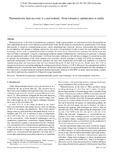Mostrar el registro sencillo del ítem
Thermoelectric heat recovery in a real industry: from laboratory optimization to reality
| dc.creator | Casi Satrústegui, Álvaro | es_ES |
| dc.creator | Araiz Vega, Miguel | es_ES |
| dc.creator | Catalán Ros, Leyre | es_ES |
| dc.creator | Astrain Ulibarrena, David | es_ES |
| dc.date.accessioned | 2021-09-03T08:46:03Z | |
| dc.date.available | 2023-02-05T00:00:13Z | |
| dc.date.issued | 2021 | |
| dc.identifier.issn | 1359-4311 | |
| dc.identifier.uri | https://hdl.handle.net/2454/40401 | |
| dc.description.abstract | Thermoelectricity, in the form of thermoelectric generators, holds a great potential in waste heat recovery, this potential has been studied and proved in several laboratory and theoretical works. By the means of a thermoelectric generator, part of the energy that normally is wasted in a manufacturing process, can be transformed into electricity, however, implementing this technology in real industries still remains a challenge and on-site tests need to be performed in order to prove the real capabilities of this technology. In this work, a computational model to simulate the behaviour of a thermoelectric generator that harvest waste heat from hot fumes is developed. Using the computational model an optimal configuration for a thermoelectric generator is obtained, also an experimental study of the performance of different heat pipes working as cold side heat exchangers is carried out in order to optimize the performance of the whole thermoelectric generator, thermal resistances of under 0,25 K/W are obtained. The optimized configuration of the thermoelectric generator has been built, installed and tested under real conditions at a rockwool manufacturing plant and experimental data has been obtained during the 30 days field test period. Results show that 4.6 W of average electrical power are produced during the testing period with an efficiency of 2.38%. Moreover, the computational model is validated using this experimental data. Furthermore, the full harvesting potential of an optimized designed that takes advantage of the whole pipe is calculated using the validated computational model, resulting in 30.8 MWh of energy harvested during a sample year which could meet the demand of 8.34 Spanish average households. | en |
| dc.description.sponsorship | The authors are indebted to the Navarra Government for economic support of this work, included in the 0011-1365-2018-000101 Research Project, also to the State Research Agency of Spain for economic support, included in the RTI2018-093501-B-C22 Project from the Research Challenges Program. We would also like to acknowledge the support from the FPU Program of the Spanish Ministry of Science, Innovation and Universities (FPU16/05203). | en |
| dc.format.extent | 16 p. | |
| dc.format.mimetype | application/pdf | en |
| dc.language.iso | eng | en |
| dc.publisher | Elsevier | en |
| dc.relation.ispartof | Applied Thermal Engineering, 184 (2021) 116275 | en |
| dc.rights | © 2020 Elsevier Ltd. This manuscript version is made available under the CC-BY-NC-ND 4.0 | en |
| dc.rights.uri | http://creativecommons.org/licenses/by-nc-nd/4.0/ | |
| dc.subject | Computational model | en |
| dc.subject | On-site experimentation | en |
| dc.subject | Passive heat-exchangers | en |
| dc.subject | Thermoelectric generator | en |
| dc.subject | Waste-heat | en |
| dc.title | Thermoelectric heat recovery in a real industry: from laboratory optimization to reality | en |
| dc.type | info:eu-repo/semantics/article | en |
| dc.type | Artículo / Artikulua | es |
| dc.contributor.department | Ingeniaritza | eu |
| dc.contributor.department | Institute of Smart Cities - ISC | en |
| dc.contributor.department | Ingeniería | es_ES |
| dc.rights.accessRights | info:eu-repo/semantics/openAccess | en |
| dc.rights.accessRights | Acceso abierto / Sarbide irekia | es |
| dc.embargo.terms | 2023-02-05 | |
| dc.identifier.doi | 10.1016/j.applthermaleng.2020.116275 | |
| dc.relation.projectID | info:eu-repo/grantAgreement/AEI/Plan Estatal de Investigación Científica y Técnica y de Innovación 2017-2020/RTI2018-093501-B-C22/ES/ | en |
| dc.relation.projectID | info:eu-repo/grantAgreement/MECD//FPU16%2F05203/ES/ | en |
| dc.relation.publisherversion | https://doi.org/10.1016/j.applthermaleng.2020.116275 | |
| dc.type.version | info:eu-repo/semantics/acceptedVersion | en |
| dc.type.version | Versión aceptada / Onetsi den bertsioa | es |
| dc.contributor.funder | Gobierno de Navarra / Nafarroako Gobernua, 0011-1365-2018-000101 | es |



